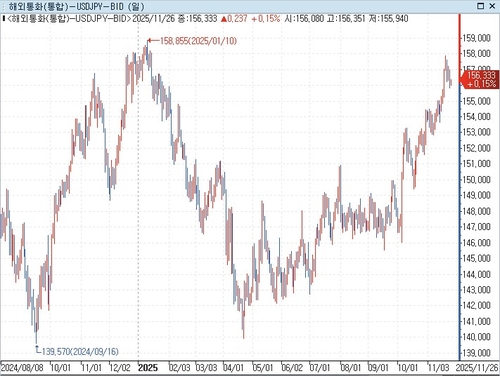
(Seoul=Yonhap Infomax) Yong Wook Kwon – Japanese foreign exchange authorities are actively weighing the possibility of market intervention as the yen continues its sharp decline against the US dollar. Market observers note that the coming month will be pivotal in determining both the likelihood of intervention and the future direction of the yen.
As of the morning of the 26th, the dollar-yen exchange rate was trading near 156 yen. The rate has recently approached 158 yen, moving once again toward the 160-yen level, widely regarded as a historic threshold for yen weakness.
This marks the first time in about a year that the dollar-yen rate has reached these levels. At the end of 2024, the yen's depreciation accelerated, with the rate briefly trading in the upper 158-yen range in January this year. At that time, neither the Japanese government nor the Bank of Japan (BOJ) intervened to support the yen, and the inauguration of the Trump administration in mid-January triggered a period of dollar weakness and yen strength.
Even amid last year's yen depreciation, the BOJ, responsible for price stability, repeatedly emphasized that import price inflation was stabilizing year-on-year.
However, the stance of Japanese foreign exchange authorities has shifted significantly compared to a year ago.
BOJ Governor Kazuo Ueda recently told the National Diet, "The ongoing yen depreciation is pushing up import prices, which in turn is being passed on to domestic prices and contributing to consumer price inflation."
He further noted, "It is important to be mindful of the possibility that exchange rate fluctuations could have a greater impact on prices."
Looking at import price trends, there is no sign of the kind of overheating that would drive domestic inflation, similar to a year ago. Nevertheless, the stronger tone in Governor Ueda's remarks is attributed to the underlying causes of the current yen weakness, according to the Nikkei.
Last year's yen depreciation was largely triggered by the so-called "Trump rally," characterized by a strong dollar, and concerns over the yen's weakness were relatively muted.
In contrast, the current situation is fundamentally driven by concerns over fiscal deterioration under the proactive fiscal policies of Prime Minister Sanae Takaichi's administration. Preventing a decline in consumption due to rising prices has become a top priority for the Takaichi government, making it imperative to avoid a scenario where yen weakness further fuels inflation.
Discussions around potential yen-buying intervention have become increasingly concrete. Finance Minister Satsuki Katayama, who has repeatedly described the yen's decline as "very one-sided and rapid," stated last weekend that "decisive action will not be ruled out" in response to the sharp depreciation.
Market analysts expect that further yen weakness and the likelihood of actual intervention will depend heavily on the outcomes of monetary policy decisions in both the US and Japan over the next month. Even if the recent "dollar buying, yen selling" trend driven by US capital repatriation subsides, upcoming decisions on a possible BOJ rate hike and a potential Federal Reserve rate cut could once again trigger volatility in capital flows.
Koji Fukaya of Market Risk Advisory told the Nikkei, "The period leading up to the mid-December policy meetings of the BOJ and the Fed will be a critical juncture in determining whether we enter another phase of historic yen weakness."
He added, "Until then, a psychological standoff between Japanese authorities and the market, including the possibility of yen-buying intervention, is likely to continue."
ywkwon@yna.co.kr
(End)
Copyright © Yonhap Infomax Unauthorized reproduction and redistribution prohibited.

